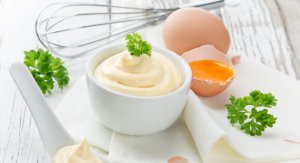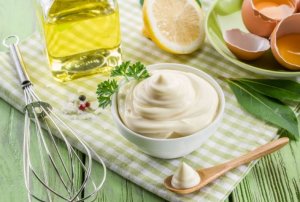Healthy Mayonnaise

Mayonnaise is a cold dressing made mainly with eggs and vegetable oil. It’s a sauce of Spanish origin (Menorcan) and is usually seasoned with lemon juice, salt or vinegar.
Today, it’s a dressing that is present in many dishes as an accompaniment, usually with vegetables and fish. It’s often still made by hand, without the use of the blender.
Commercial mayonnaise
For the preparation of commercial mayonnaise, manufacturers use raw eggs, oil, spices, salt, and natural essences. The process starts with a giant tank filled with raw eggs (that have been previously pasteurized) and stored at a cool temperature to prevent salmonella.

Then, there is a second tank that contains vegetable oil and a third tank that contains a mixture of spices, salt and natural essences in a liquid state. These tanks are stored at room temperature. Finally, a certain amount of each tank is mixed together in one common tank to obtain a creamy mass.
Once the homogeneous mixture is obtained, manufacturers take a sample for quality control, to measure its pH level. Individual containers are then filled with the product via an automatic filler. Another machine covers the product to preserve its freshness, before labeling the mayonnaise and taking it to market.
Homemade mayonnaise
To make homemade mayonnaise we need:
- 2 egg yolks
- A teaspoon of mustard
- 3 teaspoons of lemon juice
- 1 cup of olive oil
- salt, and ground black pepper
To make the dressing, we separate the yolks from the egg whites. Place the yolks, with a teaspoon of mustard and one teaspoon of lemon juice in a mixing bowl. With the blender, mix these ingredients until they have a homogeneous consistency.

Once this is well mixed, we add the olive oil little by little and continuously, until we have made the sauce. In the end, it should be a yellow and thick mixture.
Finally, we add the rest of the lemon juice and the salt and black pepper to taste, we mix everything for the last time and the mayonnaise is ready to serve.
Healthy mayonnaise
We can say that mayonnaise isn’t entirely healthy due to its high-fat content. These fats can cause cholesterol problems, cardiovascular diseases, and obesity. That’s why we’re also going to talk about how to make healthier mayonnaises.
Mayonnaise without egg recipe
In addition to not containing egg fats, this mayonnaise has the advantage that it can be heated without the mixture separating. For this mayonnaise, you just need a cup of milk, olive oil, and salt.
Its preparation consists of mixing the milk with the salt in a blender, and little by little, adding the olive oil without mixing until you get a thick paste.
To make it even lighter you can use skim or soy milk. You can also add chopped chives or garlic to change the flavor!
For storage in the refrigerator, it’s better to keep it in a glass jar.
Carrot mayonnaise recipe
Here’s a different option for when it comes to adding taste to your meals, in addition to that its preparation is easy and only needs a few ingredients. To make this recipe, we need 26.5 ounces of carrots, a quarter of a cup of olive or sunflower oil, a clove of garlic (or less if you prefer a milder flavor), a pinch of salt and a dash of lemon juice.
To start, peel and cut the carrots into thin slices and put them in a pot with water to cook them. Leave them tender but not overcooked. Let them cool and blend them with the other ingredients.
This will result in a homogeneous and smooth paste of orange color. For more flavor, add more oil. Keep it in the fridge, but we don’t recommend freezing it, as it will lose its taste.
There are many varieties of healthy mayonnaise, such as potatoes and beet, carrots with chickpeas, celery, tomatoes, and avocados. You can even make it with mango!
Mayonnaise is a cold dressing made mainly with eggs and vegetable oil. It’s a sauce of Spanish origin (Menorcan) and is usually seasoned with lemon juice, salt or vinegar.
Today, it’s a dressing that is present in many dishes as an accompaniment, usually with vegetables and fish. It’s often still made by hand, without the use of the blender.
Commercial mayonnaise
For the preparation of commercial mayonnaise, manufacturers use raw eggs, oil, spices, salt, and natural essences. The process starts with a giant tank filled with raw eggs (that have been previously pasteurized) and stored at a cool temperature to prevent salmonella.

Then, there is a second tank that contains vegetable oil and a third tank that contains a mixture of spices, salt and natural essences in a liquid state. These tanks are stored at room temperature. Finally, a certain amount of each tank is mixed together in one common tank to obtain a creamy mass.
Once the homogeneous mixture is obtained, manufacturers take a sample for quality control, to measure its pH level. Individual containers are then filled with the product via an automatic filler. Another machine covers the product to preserve its freshness, before labeling the mayonnaise and taking it to market.
Homemade mayonnaise
To make homemade mayonnaise we need:
- 2 egg yolks
- A teaspoon of mustard
- 3 teaspoons of lemon juice
- 1 cup of olive oil
- salt, and ground black pepper
To make the dressing, we separate the yolks from the egg whites. Place the yolks, with a teaspoon of mustard and one teaspoon of lemon juice in a mixing bowl. With the blender, mix these ingredients until they have a homogeneous consistency.

Once this is well mixed, we add the olive oil little by little and continuously, until we have made the sauce. In the end, it should be a yellow and thick mixture.
Finally, we add the rest of the lemon juice and the salt and black pepper to taste, we mix everything for the last time and the mayonnaise is ready to serve.
Healthy mayonnaise
We can say that mayonnaise isn’t entirely healthy due to its high-fat content. These fats can cause cholesterol problems, cardiovascular diseases, and obesity. That’s why we’re also going to talk about how to make healthier mayonnaises.
Mayonnaise without egg recipe
In addition to not containing egg fats, this mayonnaise has the advantage that it can be heated without the mixture separating. For this mayonnaise, you just need a cup of milk, olive oil, and salt.
Its preparation consists of mixing the milk with the salt in a blender, and little by little, adding the olive oil without mixing until you get a thick paste.
To make it even lighter you can use skim or soy milk. You can also add chopped chives or garlic to change the flavor!
For storage in the refrigerator, it’s better to keep it in a glass jar.
Carrot mayonnaise recipe
Here’s a different option for when it comes to adding taste to your meals, in addition to that its preparation is easy and only needs a few ingredients. To make this recipe, we need 26.5 ounces of carrots, a quarter of a cup of olive or sunflower oil, a clove of garlic (or less if you prefer a milder flavor), a pinch of salt and a dash of lemon juice.
To start, peel and cut the carrots into thin slices and put them in a pot with water to cook them. Leave them tender but not overcooked. Let them cool and blend them with the other ingredients.
This will result in a homogeneous and smooth paste of orange color. For more flavor, add more oil. Keep it in the fridge, but we don’t recommend freezing it, as it will lose its taste.
There are many varieties of healthy mayonnaise, such as potatoes and beet, carrots with chickpeas, celery, tomatoes, and avocados. You can even make it with mango!
This text is provided for informational purposes only and does not replace consultation with a professional. If in doubt, consult your specialist.








